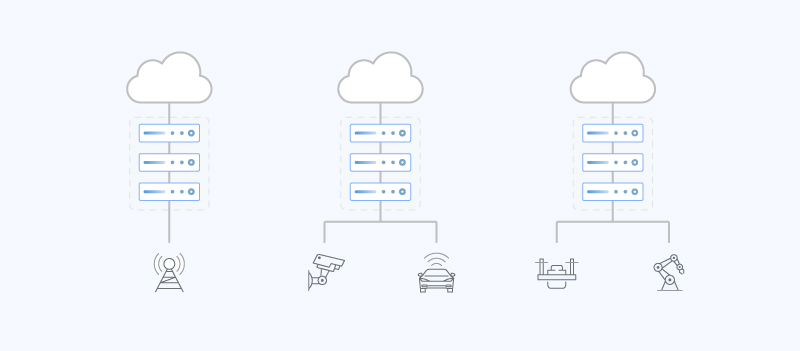Edge Computing vs. Multi-Access Edge Computing
Today, several enterprises rely on data to make critical decisions and support real-time business operations. The large amounts of data produced also mean it's difficult to sort through all of them and gain valuable insights in the shortest time possible. Businesses are solving this problem by changing how they handle data processing and computing.
Over the years, businesses have used centralized data centers where a large amount of data is sent to and from a centralized cloud for processing and analysis. This computing model faces several challenges such as latency issues, bandwidth limitations, and poor user experience due to unpredictable network disruptions.
Most of these challenges are resolved by moving a portion of the compute and storage resources out of the centralized data centers and closer to the data source. At the heart of this transformation are edge computing and Multi-access Edge Computing (MEC).
Both these technologies are reshaping the IT and business computing landscape, but there are slight differences between the two. We've highlighted these and more in the subsequent sections below.
What is Edge Computing?
Edge computing is a distributed IT architecture where the client data is processed and analyzed closer to the data source and at the network's periphery. In other words, edge computing deploys compute and storage resources at the same location where the data is produced. So instead of sending raw data to the cloud for processing, edge computing brings some cloud functionalities to the same physical location as the data source.

This computing model has also become an effective solution to the network problems caused by moving large data volumes. It also solves the time-lag problem as most apps depend on time-sensitive processing and responses.
By deploying storage and servers where the data is generated, edge computing can operate many devices over a smaller and more efficient Local Area Network (LAN). That way, ample bandwidth is used by local data-generating devices, minimizing latency and data congestion issues.
What is MEC?
MEC or Multi-access Edge Computing is a practical application of edge computing largely entwined with 5G but not exclusive to it. And just like edge computing, MEC aims to solve latency issues by increasing reliability and overall network efficiency. By cutting out the long and imperfect network path between the data servers and end users' devices, MEC improves content delivery and user experience.
Since Multi-access Edge Computing and edge computing bears lots of similarities, MEC has picked a lot of names as its application continues to expand: edge cloud, mobile edge computing, fog computing. Even so, MEC is often seen as the key to massive IoT deployments. It's also crucial for processing large data sets coming from increasingly interconnected devices.
Edge Computing and MEC Differences
Most people use the words edge computing and Multi-access Edge computing interchangeably. And while they are closely related, there are some distinct differences. First, edge computing is a network concept or model that aims at bringing IT resources such as storage and compute power closer to the data source and end-user.
On the other hand, MEC is a standard architecture or a form of edge computing that provides the much-needed compute capabilities at the network's edge and closer to the user. This architecture also helps enhance the functionality and capabilities of networks, including 5G, allowing enterprises to develop apps with greater reliability and efficiency.
In other words, MEC allows mobile network operators to enhance the operations of their networks, giving them the chance to become edge cloud providers. That way, these providers can leverage their wired and wireless infrastructure to become more agile and innovative.
Unlocking Business Opportunities with 5G MEC
With the power of edge computing, MEC, and 5G, businesses can tap into the new and exciting opportunities across different sectors, from retail manufacturing to transportation. 5G is an ultra-fast network with data speeds of over 1 Gbps. It also comes with low latency and high network reliability.

Several benefits can be realized by coupling the 5G network with MEC. These include ultra-low latency and fast data transmission speeds needed to operate the modern wave of interactive apps. Below are the main opportunities available with 5G MEC:
Smart Manufacturing – with 5G MEC, performance tracking capabilities can easily integrate with advanced robotics and IoT while handling huge data loads in real-time. The result is the rapid deployment of smart factories, allowing manufacturers to streamline their operations.
Immersive User Experience – Using 5G MEC technologies, companies can develop real-world environments with apps, from immersive business meetings to low-latency VR gaming experiences.
Real-time Video Analytics – 5G MEC capabilities makes it possible to handle and process large data sets from individual cameras without the need to send data to and from the cloud. This allows for accurate threat detection in real-time for immediate action.
Better IoT Capabilities – With 5G MEC technology, IoT deployments allow huge amounts of data to be captured, stored, and processed in real-time. This optimizes business processes and value delivery to customers.
Getting Started With Edge Computing and 5G MEC
Edge computing and 5G MEC offer many benefits to businesses of all types and sizes. Not only do these technologies enhance speed and scalability, but they also provide some security advantages. If you are looking to deploy edge computing or 5G MEC in your business, consider working with an expert IT company to ensure you achieve the best possible results.
You might be interested in
Email Address

-
PoE vs PoE+ vs PoE++ Switch: How to Choose?
Mar 16, 2023















